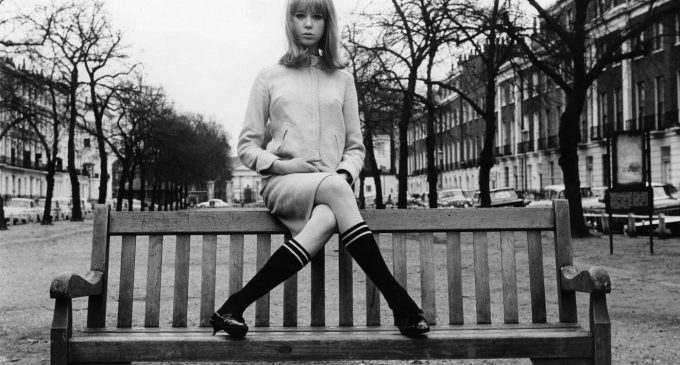1960s It Girl Pattie Boyd Talks Mary Quant – Vogue

Just as Mary Quant’s name is synonymous with miniskirts, makeup, and Mods, so Pattie Boyd’s is with London’s 1960s Youthquake (and, of course, The Beatles). Leggy, blonde, with deep bangs, blue eyes, and an oval face, Boyd, who was a model and later a photographer, embodied one of the era’s beauty ideals. More importantly, she became an exemplar of antiestablishment youth. “There was a time when every girl under 20 yearned to look like an experienced, sophisticated 30,” wrote Quant in her 1965 memoir, Quant by Quant. “[Now] their ambition is to look like Pattie Boyd, rather than Marlene Dietrich.” The next year Vogue would link Boyd to Quant when it introduced the model and her husband to its readers, writing: “They’re young. They’re doing things. They’re in the Quant spirit. He’s George Harrison, MBE, and she’s Pattie Boyd, Bride of the Beatle. A long-legged, yellow-haired duck of a girl who looks as though she’d sprung full-blown from Mary Quant’s drawing board, Mrs. H models and acts; met her husband on the set of A Hard Day’s Night.”
Given all this, Boyd seemed the perfect person to chat with about Dame Quant, whose work is being celebrated in a new exhibition at the V&A Museum in London. There, visitors will find drawings and ephemera alongside Quant designs, which are as rare as hen’s teeth, in part because there weren’t huge production runs, but mostly because they were so loved that they were worn to bits or borrowed and never returned. “I used to lend clothes to so many girls all the time, and I didn’t always get them back. I’m sad to say that I don’t have anything of Mary’s,” said Boyd, who famously was married in a custom Quant design.
“When George and I met up with Mary,” said Boyd from London, “and we told her that we were getting married, she said, ‘I want to make your wedding coats,’ because we were getting married in January and it was still cold. She made the most beautiful black Mongolian fur coat for George and a red fox coat for me. Mine was a really short coat and it was very modern.”
Mod is short for modern, and it’s the look Quant is associated with. Quant, wrote Vogue, “started the revolution in English clothes, the Mod look that took over practically around the world.” Mod is also synonymous with youth culture, which is a post-World War II phenomenon. “When we grew up,” explained Boyd, who moved to London when she was 18, “we weren’t really teenagers. We were children and then we were kind of grown up [and] wearing a version of our mother’s clothes—twinsets and pearls and, you know, that kind of tweedy skirt—it was all very English and prim, and then there was this unbelievable kind of fashion explosion when we realized we could wear short skirts and dresses.”
Although Quant writes that the miniskirt had been around since the late 1950s, it became fashionable in the mid-’60s, when André Courrèges presented it at the couture show in Paris and Quant made it available to the girl in the street. It also became a controversial symbol of the era, representing women’s liberation or promiscuity, depending on who was looking. “It was difficult to understand why [people] were shocked,” wrote Quant. “The mini was a way for young people to assert themselves. Youth was changing forever. It hadn’t had a voice until that point. The clothes and fashion freed them from the claustrophobic clothes from before. I think the miniskirt was the impetus for it all—and jazz. The two together were a combination and a catalyst.”
Jazz isn’t the soundtrack Boyd would choose for Mary’s career (though she says she can imagine Alexander Plunket Greene, Quant’s aristocratic and sophisticated husband, listening to it). Her pick would be the Beach Boys’s “Good Vibrations.” There were plenty of those back then in London, which was indisputably the center of a new sound, energy, and look. “Everything creative bloomed at the same time, all these creative people were there in the streets making clothes or designing cars or opening up the most beautiful boutiques. There was an air of possibility around. Anything you could think of was all possible.” That included chance meetings.
Boyd met Quant casually through her flatmate Mary, a model who was working at the designer’s buzzing Bazaar boutique on King’s Road in Chelsea. This thoroughfare became the main artery of the youth movement and a sort of runway for the new gen. Boyd remembers “cruising” down the street and enjoying the people-watching. “The guys,” she noted, “had started growing their hair long, so they were looking beautiful.” And the girls? “Legginess. It was all about legs,” wrote Quant. Color and shape were part of the appeal as well. “What I really liked about Mary’s clothes was that not only were they short and adorable, but the colors were spectacular,” Boyd stated. “They were just wonderful color combinations, and I loved her geometric designs on the dresses.”
Mods like Quant and Boyd were anything but square; Americans were slower to embrace the youth revolution. In 1965 Quant and Plunket Greene, along with a gaggle of models, including Boyd and her sister Jenny, traveled to New York to promote the Youthquake line the designer had developed with Puritan, an American manufacturer. “When we arrived in New York, we were taken to The Algonquin Hotel. It was so glamorous, and so fabulous, and we loved it until we realized we weren’t allowed to go into the dining wearing trousers,” recalled Boyd. “And I said, ‘Even Mary Quant’s trousers? This is ridiculous!’ I think they really meant jeans, but [America] was very puritanical in those days.” In comparison, London was swinging: “Rules,“ observed Quant, “are totally irrelevant to modern-day living.”







There are no comments at the moment, do you want to add one?
Write a comment